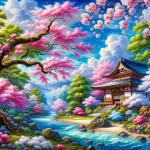The significance of cherry blossom season extends beyond the visual feast it provides. For both tourists and locals alike, Sakura holds a special place in the collective heart of the nation. It's a time when people all around converge under the blossoming canopies for 'hanami'—the traditional custom of enjoying the transient beauty of flowers. In these moments, the air is filled with a convivial spirit, bridging the gap between nature's splendor and human camaraderie.
Initial Tips for Australians Travelling to Japan During This Period
Aussie travellers looking to partake in this beautiful ritual should consider a few tips before embarking. Timing is key; the Sakura bloom sweeps the country at different times, starting in the southern island of Okinawa all the way to Hokkaido in the north. Hence, it's crucial to check the cherry blossom forecast to align your visit accordingly. Additionally, bringing comfortable walking shoes is a must, as the best experiences often come from strolling through lanes lined with cherry trees or exploring Japan's picturesque parks and gardens. Lastly, the spring weather can be unpredictable, with warm days and chilly evenings, which necessitates packing layers to adapt seamlessly to the changing temperatures.
Understanding Cherry Blossom Season
The Cultural Importance of Cherry Blossoms in Japan
In Japan, cherry blossoms, or 'Sakura', are laden with profound historical and cultural significance. The brevity of the blossoms serves as a metaphor for life's ephemeral nature, a core concept in Japanese aesthetics. The Sakura season prompts joyous celebrations and festivity, but it also invites contemplation of the fleeting beauty inherent in our existence.
The Sakura's cultural imprint can be seen everywhere during the season—from themed foods and beverages to music and art. The blossoms inspire a collective pause across the nation, where people reflect, indulge in poetry, and appreciate the present moment, making it an incredibly meaningful time to visit.
Typical Cherry Blossom Forecasting and the Best Time to Visit
Cherry blossom forecasting or 'sakura-zensen' is a much-anticipated annual activity. Experts scrutinize the weather patterns to predict when the trees will bloom. This forecast is crucial as the Sakura season is notoriously fickle, typically lasting only a week or two. The window for peak blooming, known as 'mankai', varies by region and can occur anytime from late March to early May.
For Aussies looking to witness this natural wonder, it's best to monitor these forecasts and plan for flexibility in travel dates. Keep an eye on regions you intend to visit as they can experience 'mankai' at different times. This ensures you maximize your chances of experiencing the cherry blossoms in full glory.
Popular Cherry Blossom Spots Across Japan
Japan boasts a myriad of spots renowned for their cherry blossom displays. Among the most iconic is Tokyo's Ueno Park, where thousands of trees create a dramatic floral canopy. In Kyoto, the Philosopher's Path provides a tranquil escape, lined with cherry trees that reflect beautifully on a canal below. Meanwhile, Hirosaki Castle in Aomori is framed by over 2,500 trees, a breathtaking sight against the historic backdrop.
Not to be overlooked, smaller towns and rural areas also provide intimate cherry blossom experiences. Kawazu, for instance, is home to some of the earliest blooms in Japan, attracting those eager to catch the first sights of Sakura. Wherever you choose to go, each location offers its unique view and atmosphere, contributing to an unforgettable Sakura season.
Weather and Clothing Essentials
What to Expect from the Spring Climate in Various Regions of Japan
Spring in Japan is as diverse as its landscape. Starting in the subtropical south, Okinawa enjoys a warmer and milder climate, perfect for lighter attire. As you travel north towards Tokyo and Kyoto, expect a mix of mild to cool temperatures. The change can be brisk, so a versatile wardrobe is key. Come late spring, northernmost regions like Hokkaido welcome spring later than the rest of Japan, holding onto winter's chill a bit longer, so wrapping up warmly there is advisable.
Regardless of the region, spring is known for its fair share of rainy days, particularly in June, the start of the rainy season or 'tsuyu'. This variability in weather makes layers your best friend when packing for a trip to Japan during cherry blossom season.
Key Clothing Items to Pack, Including Layering Tips
Packing smart is essential for comfort and convenience during your Sakura viewing trip. Lightweight, long-sleeved tops can be layered with cardigans or a fleece for those cooler moments. Add a versatile, waterproof jacket that shields against unexpected downpours without adding bulk. Bottoms should include comfortable jeans or trousers with some stretch—and don't forget leggings or tights for an extra layer of warmth under skirts.
For days out exploring, pack a mix of short and long-sleeve T-shirts that can be peeled off as needed. As evenings tend to be cooler, bring a warm jumper or hoodie to throw on when the temperature dips. A foldable, packable down vest or jacket can also be a game-changer, offering warmth without the weight.
Considerations for Both Wet and Dry Weather Conditions
Being prepared for both wet and dry conditions will ensure you're never caught off guard. A small, lightweight umbrella is a must-have, easily stowed in your daypack. Water-resistant footwear is prudent, especially for those planning to wander off the beaten path where paths might be muddy. Choose shoes that are comfortable for long walks, as hanami often involves a lot of strolling and standing.
Lastly, consider adding a few accessories that could make a big difference. Sunglasses for sunny days, a wide-brimmed hat, and a scarf for versatility should also find a place in your luggage. With these items at the ready, you're well-equipped to enjoy Japan's spring season with ease and style.
Gadgets and Tech Must-Haves
Technical Essentials for Capturing the Sakura Season
With Japan's cherry blossoms providing a stunning backdrop, capturing the beauty of Sakura season is a priority for many travellers. A high-quality camera or a smartphone with a good camera is essential. Consider extra memory cards and backup batteries to ensure you can snap photos all day. For those keen on videography, a lightweight tripod or a stabilizing gimbal can help you achieve those smooth shots amidst the bustling hanami gatherings.
Aside from photography gear, a good pair of binoculars can enhance the experience, allowing you to view the cherry blossoms up close even if you're stationed at a distance. This is particularly useful in popular spots that may be crowded.
Useful Apps and Tools for Navigation and Communication
Staying oriented and connected is crucial when traveling abroad. For Aussies in Japan during Sakura season, downloading local maps to your device in advance is a wise move. Apps like Google Maps and Citymapper offer offline options, ensuring you can find your way around even without a data connection. Translation apps can also be invaluable for deciphering signs and menus, and for helping with everyday communication.
Social media and messaging apps are also important to keep in touch with fellow travelers or new friends. Ensure you have set up international data or have access to local Wi-Fi to use these services seamlessly.
Power Adapters and Charging Equipment
Japan's electrical outlets may differ from what you're used to, so bringing a suitable power adapter is essential. Check and double-check the type of plug and voltage used in Japan to ensure compatibility with your devices. A portable power bank will also be a lifesaver, keeping your devices charged during those long days of exploration.
For added convenience, consider a multi-port USB charger, which allows you to charge multiple devices at once, saving time and outlet space. With the right power solutions, you can relax and enjoy the cherry blossoms without worrying about a draining battery.
Health, Comfort, and Personal Care
Personal Care Items Specific to Spring Allergens and Sun Protection
Japan's Sakura season, while beautiful, can coincide with spring allergens, particularly pollen. Aussies travelling to Japan should pack anti-histamines or allergy relief medication, especially if they are sensitive to tree pollen. It’s also important to have a small first-aid kit for unexpected scrapes or aches after a full day of sightseeing.
Sun protection should not be overlooked. The gentle spring sun can still be quite strong, so bring a high-SPF sunscreen, lip balm with sunblock, and after-sun lotion to soothe any burns. Ensure that your daypack always has these items so you can reapply as needed during your outdoor adventures.
Staying Comfortable During Long Walks and Picnics Under the Sakura
Comfort during long walks and while lounging under the cherry blossoms is crucial. Good quality, supportive footwear will make the experience more enjoyable and help prevent foot fatigue. It's also wise to pack a lightweight and compact seat cushion or portable chair for those popular hanami picnic spots, ensuring you have a comfortable place to sit.
Another addition to your comfort kit is a reusable water bottle. Staying hydrated is important, and many parks have public water fountains where you can fill up for free. Also, consider carrying a light picnic blanket—many of which are designed to fold up small—ideal for an impromptu picnic beneath the blossoms.
Health Insurance and Travel Safety Tips
Travelling with a valid health insurance policy is essential. Before departing Australia, confirm that your insurance plan covers international travels and understand how to proceed in case you need medical assistance in Japan. Knowing the location of nearby clinics or hospitals, as well as emergency contact numbers, will give you peace of mind.
As always, safety is paramount. Keep your belongings secure and be aware of your surroundings, especially in crowded areas. It’s recommended to make digital copies of important documents and keep them in a secure online storage that you can access if needed. Precaution, care, and common sense will help ensure your visit is as enjoyable and problem-free as possible.
Sightseeing and Festival Gear
Essential Gear for Engaging in Hanami (Flower Viewing) Activities
Participating in hanami is a highlight of visiting Japan during the cherry blossom season. Essential gear includes a reliable picnic blanket that is waterproof and easy to fold. A compact, lightweight picnic basket or cooler bag will make transporting your snacks and drinks easier. Don't forget eco-friendly utensils and a trash bag to ensure you leave the viewing spots as pristine as you found them.
For photography enthusiasts, lightweight, foldable reflectors can help capture the perfect Sakura shot by manipulating the natural light. Also, carrying a small, portable blue-tooth speaker could enrich the experience with your favorite tunes, though always be mindful of others when playing music in public spaces.
Packing for Other Cultural Experiences and Festivals
The cherry blossom season often coincides with various Japanese cultural festivals, so packing attire that is respectful and appropriate for attending local events is advised. Include clothing that is easy to move around in, for festivals often involve a lot of walking and sometimes traditional dancing.
Exploring other facets of Japanese culture, like tea ceremonies or visits to shrines, requires modest attire. A scarf or shawl for wrapping around your shoulders is a versatile accessory that can be used for such occasions. Including a small, eco-friendly shopping bag is also wise, as many festivals have market stalls selling artisanal goods and food.
Recommendations on Footwear and Portable Seating Options
Comfortable footwear is crucial for the extensive walking involved in sightseeing. Choose breathable, cushioned walking shoes or sneakers that can support your feet throughout the day. If you're visiting gardens or historic homes, slip-on shoes are a practical choice as you may need to remove them frequently.
When it comes to seating, while many hanami spots are sit-on-the-ground picnics, portable seating can be a boon. Lightweight folding chairs or stools that pack flat can greatly enhance your comfort during prolonged sitting. Telescopic walking poles with sit-sticks might be worth considering for those wanting the dual function of walking support and a makeshift seat.
Culinary Considerations
Seasonal Food and Drink to Try During the Sakura Season
Japan's Sakura season is not just a feast for the eyes but also for the palate. The season ushers in a plethora of limited-time culinary delights influenced by the cherry blossoms themselves. Travellers should not miss sampling 'sakura-mochi', a sweet rice cake wrapped in a pickled cherry leaf. Similarly, 'hanami dango', skewered rice dumplings in pastel colors, are a treat both visually and gastronomically.
The springtime brings a surge of 'sakura-flavored' beverages and desserts, including lattes, ice creams, and candies, which are usually subtly flavored and elegantly packaged. For a more savory experience, seasonal bento boxes can feature Sakura-themed ingredients, making for both a tasty and eye-catching meal.
Packing Snacks and Dietary Requirements for Travellers
When packing for Japan during cherry blossom season, it’s smart to include some familiar snacks, especially for those with dietary restrictions or particular food preferences. While Japan offers a bountiful array of snacks, finding gluten-free or vegan options on the go can sometimes be challenging.
Bringing along snack bars, trail mix, or other non-perishable items can help tide you over between meals or when options are scarce. Moreover, having snacks handy is convenient for long days of sightseeing or impromptu picnics under the cherry blossoms.
Tips for Dining Out in Japan and Etiquette Reminders
Dining out in Japan is an experience in itself, with a spectrum ranging from street food stalls to high-end restaurants. For a casual bite, 'yatai' food stalls are great for trying local specialties, like 'takoyaki' or 'okonomiyaki'. When attending more formal dining establishments, reservations are often required, and it is respectful to be punctual.
Japanese dining etiquette favors consideration for others. It’s polite to say 'itadakimasu' before eating and 'gochisosama deshita' after finishing a meal. Remembering to use your chopsticks correctly is also crucial—avoid sticking them vertically in rice, as this resembles a funeral rite. Use the chopstick rest when not eating, and refrain from passing food directly from your chopsticks to someone else's, as this too is associated with funeral customs.
Accommodation and Transportation Tips
Choosing the Right Accommodation for Cherry Blossom Tours
Securing the best accommodation for your cherry blossom adventure should combine comfort, affordability, and convenience. Options range from traditional Japanese inns, known as 'ryokans', offering a cultural experience, to modern hotels with Western amenities. Prioritize locations that provide easy access to prime 'hanami' spots. Booking well in advance is advisable, as this period sees a surge in visitors.
Budget travelers may consider capsule hotels or hostels. These are not only wallet-friendly but often centrally located. For a more immersive experience, look for a 'minshuku'—a family-run bed-and-breakfast, where you'll enjoy home-cooked meals and the warmth of Japanese hospitality. Regardless of your choice, ensure it aligns with your itinerary to reduce unnecessary commute time.
Transportation Tips: Rail Passes and Inner-City Travel
Public transportation in Japan is renowned for its efficiency and punctuality, making it a preferred mode of transit. For travelers planning to visit multiple regions, a Japan Rail (JR) Pass can offer unlimited travel on most JR trains, including the Shinkansen (bullet train), for a set number of days. Pre-purchase this pass outside of Japan for significant savings.
Inner-city travel is just as convenient with a multitude of options including subways, buses, and taxis. For ease, consider a rechargeable 'IC' card such as Suica or Pasmo, which can be used across various forms of public transport. Remember to factor in the rush hour in big cities; trains might be crowded, so plan accordingly to avoid inconvenience.
Maximizing Your Sightseeing with Strategic Planning
Tactical planning can greatly enhance your cherry blossom experience. Researching and selecting accommodations close to major attractions or transportation hubs can save time and energy. Additionally, many cities provide day or multi-day passes for unlimited travel on public transit, which is cost-effective for intensive sightseeing days.
Create an itinerary that groups nearby attractions together, minimizing back-and-forth trips across the city. Utilize early mornings to visit popular locations for fewer crowds and tranquil viewing. Finally, stay flexible; cherry blossoms are unpredictable, so being able to adjust your plans based on bloom forecasts is essential for a rewarding journey.
Sustainable Travel and Cultural Respect
Practicing Sustainable Travel During Peak Tourist Season
Tourism can take a toll on local environments, particularly during peak seasons like Sakura in Japan. To practice sustainable travel, tourists should consider reducing their carbon footprint. This can include using public transportation, walking or biking when possible. Additionally, supporting local businesses rather than international chains can help sustain the local economy and preserve the cultural uniqueness of the places you visit.
Also, being mindful of waste by disposing of trash responsibly and reducing plastic usage are small but significant steps. Utilizing reusable bottles, bags, and containers minimizes our impact and encourages a cleaner, greener visit amidst the cherry blossoms.
Understanding Sakura-Related Customs and Traditions
Understanding and respecting Sakura-related customs enhance the richness of the experience. 'Hanami', the practice of flower viewing, is a time for joyous celebration—but it's also steeped in tradition. It's important to recognize this and engage in the practice thoughtfully. Part of this means being prepared to sit quietly and reflect, rather than treating these sites as mere backdrops for photography.
Celebrating the Sakura season also entails partaking in seasonal festivals with historical significance. Taking the time to learn about these can express respect for the culture and deepen your personal connection with the country and its traditions.
Respecting the Environment and Local Etiquettes
Respecting the environment goes hand in hand with respecting local etiquette. The Japanese are known for their meticulous care for nature and public spaces. When enjoying the Sakura, it is crucial to maintain cleanliness and order by using designated garbage and recycling bins, and avoiding picking flowers or damaging trees.
Local customs such as bowing, removing shoes before entering certain spaces, and being courteous in crowded places are deeply valued in Japan. Visitors should endeavor to observe these practices, demonstrating an appreciation for the local lifestyle and contributing positively to the cultural ambiance of the Sakura season.
Conclusion: Making the Most of Your Cherry Blossom Experience
Final Checklist Recap for Australians Heading to Japan
As our exploration of the cherry blossom season comes to a close, let's recap the essentials for Australians traveling to Japan for this spectacular time of year. Ensure you have comfortable, adaptable clothing for the varying spring temperatures and be prepared for rain or shine with suitable gear. Technological must-haves include a quality camera or smartphone, relevant power adapters, and apps to navigate and communicate. Don't forget to pack personal care items for health, comfort, and sun protection, along with snacks that cater to your dietary needs.
Equip yourself with hanami-specific items like a picnic blanket and eco-friendly utensils, immerse in cultural festivities with appropriate attire, and prepare for extensive walking with good footwear. Staying organized with your accommodation and transportation arrangements, including potential rail passes, will help maximize your sightseeing opportunities. Finally, maintain awareness of sustainable travel practices and cultural etiquette to fully respect the environment and the traditions of your host country.
Encouraging Immersive and Responsible Travel
Your journey to Japan during cherry blossom season is an opportunity to immerse yourself in the country's unique cultural landscape. Engage with local communities, try traditional foods, and partake in festivals to gain a deeper appreciation of Japan's heritage. Being a responsible traveller also means being environmentally conscious, taking steps to minimize your impact, and celebrating the natural beauty without leaving a trace.
Parting Thoughts and Wishes for a Memorable Trip
As you venture out to experience the captivating allure of cherry blossoms, remember that the true essence of this special season lies not just in the visual delight of blooming sakura but in the shared moments and memories created. The Sakura is a fleeting marvel—a reminder to cherish the present. Take this time to reflect on the transient beauty that unfolds before you, and let it inspire your journey. Safe travels, and may your trip to Japan be a tapestry of unforgettable moments that you’ll carry with you long after the petals have fallen.
Published: Monday 29th January, 2024
Last updated: Sunday 7th January, 2024









